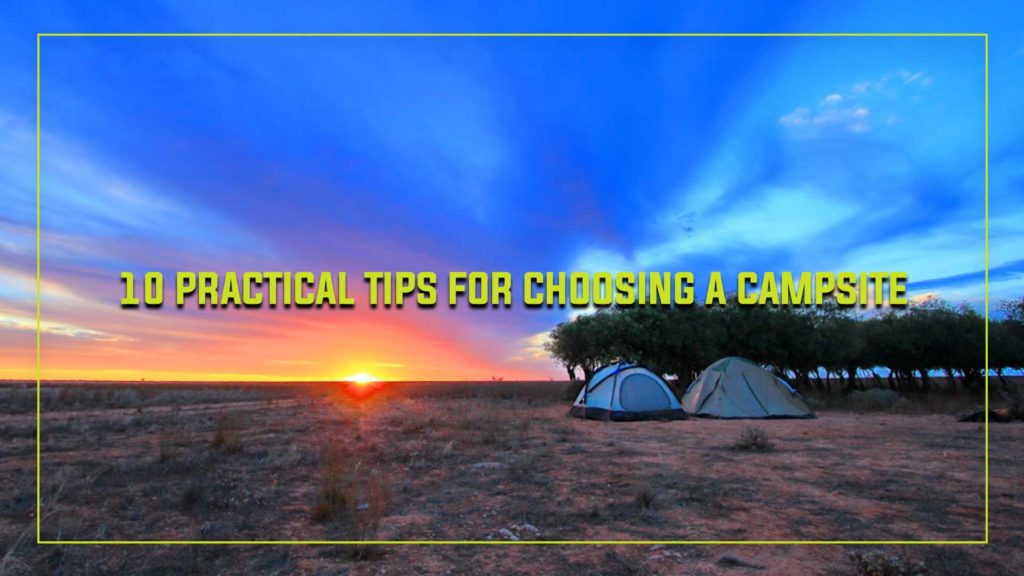

READY FOR THE NEXT ADVENTURE?
Subscribe to receive practical tips and tricks from experienced travellers who love Australia as much as you do.
Arrives in your inbox monthly. Exclusive access content. No spam, ever.

Even with the best, most comfortable tent on the market, you can’t guarantee a good night’s sleep if you’ve chosen the wrong campsite. There’s no doubt you’ll struggle to relax if high winds are constantly knocking your tent around, or if you’re sleeping on hard-packed ground and waking up every morning with a sore back.
Want to ensure a good night’s sleep after exploring the outdoors? In that case, you’ll want to choose the right campsite from the get-go. Aside from bringing high-quality camping gear, consider the following tips when choosing a location for your outdoor adventure:
Unless you’re planning on sleeping in a hammock, you’ll have to set your tent up in a fairly level area – and that means avoiding slopes!
Although some people suggest sleeping on a slope for various reasons (such as needing to elevate your head to avoid getting stuffy), we recommend using other methods that won’t mess with your circulation.
Pillows are one of the simplest and easiest ways to elevate different parts of your body for relief. Not enough room to pack lots of pillows? Simply use rolled up jumpers, jackets or blankets instead.
Are you bringing an RV to the site? If that’s the case, feel free to skip this tip. On the other hand, if you’re rocking up with a tent for shelter, you’ll need to check out the drainage on-site, to make sure the surrounding area isn’t sloping towards your campsite.
If you set up camp in an area like this, your shelter may flood when it starts raining. And let’s face it – having to move your tent is not something you want to deal with in the middle of the night.
No matter what type of shelter you choose, you need to consider what direction the doors will face. If there are other campers nearby, this is a handy tip to consider.
If you’re camping with your kids, you’d probably want your tent’s door to face your children’s. In this way, you can easily supervise the young ones and see what they’re up to.
On the other hand, if you’re bringing a campervan on site with several people, make sure that the door is facing away from other campers. You can also gain some easy privacy if you find a tree to block your door. By parking your caravan in such an area, you can comfortably get in and out of your campervan to use the bathroom in the middle of the night.
During colder months, consider where the sun will rise. This way, you can orient your shelter and make sure the sun will hit it early, allowing you to enjoy some comforting warmth in the morning.
If you’re planning a trip during the warmer seasons, keep a lookout for rocky outcrops and areas with more trees. Doing so will allow you to benefit from shadows and shade earlier than the setting of the sun.
You should also physically inspect the trees in the area. After all, you don’t want strong winds causing debris and branches to fall on your tent!
Popular campgrounds usually have multiple high-traffic areas. These may be places with water sources and bathrooms.
If possible, find a location that people don’t frequently visit. You don’t want to stay awake all night because of loud groups of people!
Kids can quickly get bored when there’s nothing to do around the campsite. If you’re bringing children along, consider choosing a location with easy access to creeks, interesting rocks and stunning trees.
Check photos or reviews that previous campers have left online. You can also check maps of the site to see if there are any bodies of water nearby. This way, your kids will have plenty of fun activities to do during the day.
Go through your tent footprint and make sure there are no sharp objects like pinecones or rocks. You wouldn’t want to pitch your tent in an area that will only puncture your sleeping bags or give you any kind of discomfort.
Thinking about dispersed camping? If you’re not setting up tents in a designated campground, you should follow the 60 metre rule.
Make sure that you are at least 60 metres away from the edges of bodies of water like rivers, lakes and ponds. Doing so will lessen your ecological impact on the area.
Following this rule will prevent other hikers from wandering into your site at night. When camping, it’s always good practice to pitch your tent at least 60 metres from where you use the toilet and clean your dishes.
Always remember to check if a campground has proper waste disposal. Otherwise, you should make a plan on how you can make cleaning up easier.
One great idea is to bring a collapsible water container. This way, you won’t have to worry about throwing away the container once you’re ready to leave. You can easily store it in your vehicle, and bring it along on future camping trips!
Aside from choosing the ideal campsite, it’s important to make sure you have all the correct camping gear with you. From furniture and cookware to RV and caravan accessories, Supex Products has all the items necessary for making your trip safe and comfortable.
Find your nearest Supex stockist today to get your supplies!









Tag @supexproducts and use hashtag #FindYourPath if you would like to be featured.
9 Lockyer Street Goulburn NSW 2580 Australia
T 02 4823 6001 E [email protected]

Subscribe to receive practical tips and tricks from experienced travellers who love Australia as much as you do.
Arrives in your inbox monthly. Exclusive access content. No spam, ever.